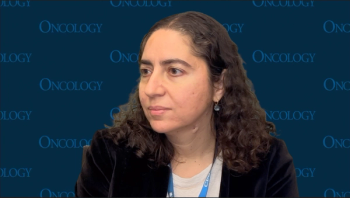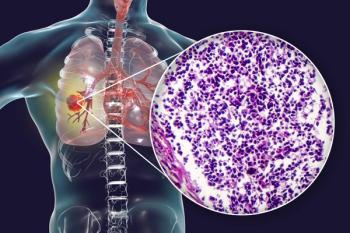
- ONCOLOGY® Companion, Volume 39, Supplement 5
- Issue 5
- Pages: 3-5
Tarlatamab and the ES-SCLC Treatment Landscape: Managing AEs and Educating Patients
Experts discuss innovative treatments for extensive-stage small cell lung cancer, highlighting tarlatamab's potential and management of adverse effects.
As part of an Around the Practice: Institutional Insights program hosted by CancerNetwork®, a panel of experts from the University of Maryland Marlene and Stewart Greenebaum Comprehensive Cancer Center in Baltimore discussed the landscape of treatment for patients with extensive-stage small cell lung cancer (ES-SCLC). The panel identified tarlatamab-dlle (Imdelltra) as an agent of interest, particularly because of its DLL3-targeting nature. They also discussed adverse effects (AEs) that arise from tarlatamab treatment, such as immune effector cell–associated neurotoxicity syndrome (ICANS) and cytokine release syndrome (CRS).
The panel was led by Samuel Rosner, MD, an assistant professor of medicine. He was joined by Ranee Mehra, MD, the director of head and neck oncology in the Division of Hematology and Oncology, head of the Solid Tumor Section, interim associate director for clinical research, and professor of medicine; Michelle Sittig, RN, OCN, a nurse coordinator with the thoracic oncology team; and Kaitlyn Whyman, DNP, CRNP, AGACNP-BC, an acute care nurse practitioner.
Lay of the Land
Mehra/ The frontline [ES-SCLC] setting has largely been informed by 2 trials, and they both incorporated immune checkpoint inhibitors with our standard backbone of platinum [therapy] and etoposide. In the [phase 3 IMpower133 trial (NCT02763579)], patients received atezolizumab [Tecentriq] with platinum [therapy] and etoposide followed by maintenance treatment.1 In the [phase 3 CASPIAN study (NCT03043872)], it was largely the same paradigm, but with durvalumab [Imfinzi] with platinum [therapy] and etoposide followed by maintenance therapy.2 Both those studies showed an improvement in overall survival with the addition of the immune checkpoint inhibitor to standard chemotherapy.
Prior to those trials, patients received 6 cycles of chemotherapy and then were on a treatment break. They often progressed very quickly during that time. Now there are effective treatment options that can be continued and that are tolerated well. It’s resulted in better quality of life and longer survival for patients in that setting. However, oftentimes, they will eventually progress.
Rosner/ Despite this wonderful advancement of the immune checkpoint blockade, the vast majority of our patients are sadly going to progress. Talking a little about what we do in that second-line setting, what are some factors that you’re thinking about? And what are some treatment options that we currently have available for patients?
Mehra/ In the second-line setting, topotecan [Hycamtin] is the historical agent that’s been used. More recently, lurbinectedin [Zepzelca] has been a treatment option as well, and this has resulted in improvements in survival in that setting. However, it is also associated with much of the toxicity that we often see with cytotoxic therapy.
Recent Clinical Trials in ES-SCLC
Rosner/ What’s been emerging in that second-line [ES-SCLC] setting of late?
Mehra/ There are a couple of interesting [trials]. One is the [phase 3 IMforte trial (NCT05091567)], which incorporates lurbinectedin as a potential addition to maintenance therapy with atezolizumab.3 That’s a randomized trial where after the standard induction treatment with the platinum and etoposide and atezolizumab, they’re [randomly assigned] to ongoing standard therapy or the addition of lurbinectedin. We’re awaiting the results of that trial, but that would inform maintenance therapy. And the other approach…is the incorporation of tarlatamab earlier in the frontline treatment setting.
The [phase 2 DeLLphi-301 study (NCT05060016)] was the key study incorporating tarlatamab.4 Those patients were extensively pretreated; about one-third received at least 3 lines of prior therapy, and 70% to 80% had a prior immune checkpoint inhibitor. This was a patient population who had progressed on the standard options. The key feature for the trial was that many of the tumors did have DLL3 expression—over 95% had DLL3 expression, which is relevant for the mechanism of action for this agent. It did show encouraging activity. Response rates were 40%, and in this heavily pretreated patient population, there was a median overall survival improvement to 15 months.
Rosner/ How do these trials impact your decision-making when you see a patient who’s progressed on chemoimmunotherapy?
Mehra/ Performance status is the key. The other important factor is whether they have brain metastases or not. We do know that tarlatamab can have activity in the brain, whereas this may not be true for all the other cytotoxic agents that we could use.
Tarlatamab Protocol
Rosner/ What’s the protocol in terms of getting tarlatamab started here and working with our community partners?
Sittig/ To get it started took a lot with the pharmacy. You need to have everyone on board, from the administration to the pharmacy to the inpatient and outpatient [clinics]. Once we were able to get it up and running, we’ve been successful with it. Now we’re starting to see patients go back into the community. It takes [the community] time to set up their sites, modeling after what we’ve done.
Rosner/ What are some challenges that you’ve seen, from starting a patient to trying to transition them to the outpatient setting?
Sittig/ [You need to have] a lot of communication with the patient to make sure they have a full understanding. The inpatient dosing is tough. They have significant AEs…. Making sure they have a good, strong up-front understanding of what it entails with dosing every 2 weeks, indefinitely. We work hard to make sure the patients, their families, and their caregivers understand the intensity of this regimen.
Rosner/ Especially on the inpatient side of it, what’s logistically something that other institutions should be aware of?
Whyman/ Whenever you start a new therapy, you want to follow protocols and standardization. What we’ve learned along the way is not to do a one-size-fits-all model [because] while that 24-hour to 48-hour monitor[ing] period is important, we’re learning that you can tell a lot about how someone’s going to react to their second dose after their first dose. Potentially keeping them longer or monitoring them closer for certain AEs, as opposed to checking those boxes of “We should do this vs this vs this.” Paying attention to how they respond to that first dose and then monitoring them in the second dose [has been helpful].
Rosner/ In terms of coordinating care, especially in that inpatient setting, who are the key players that you’re trying to rely on when you’re starting therapy for these patients?
Whyman/ Our pharmacists…. They’re a big part of our team who help us build these plans and protocols. As the provider, I make sure that I’m in touch with them and the nurses on our unit, for whom this has been a big practice change. These are new drugs with very different sets of monitoring that they have to do. Making sure everyone’s comfortable with that and knowing when we’re proceeding and how we’re proceeding has been a big hurdle.
AE Management
Rosner/ In your experience, what have been some examples in terms of symptoms that have been noticed? How are those captured? How are those graded? When you notice them, how are you treating them?
Whyman/ One of the biggest things that we normally notice in patients is initial confusion. Parts of the ICANS assessment are general “Who are you?” “Where are you?” and “Why are you here?” questions. We noticed that first, but another thing that we notice with these therapies is those very subtle issues with dexterity and fine motor movement. You often will see patients struggling to write their name or struggling to use their utensils when eating dinner or lunch, or their family knows they’re a bit more unsteady when they’re getting up to [go to] the bathroom. All that is also captured within our general treatment.
The standard of care is treatment with dexamethasone. At our institution, we do a very good job of following the general grading of CRS that is provided by tarlatamab for us to look at. I have found that dexamethasone is efficient in getting things under control. We have many patients where we give them 1 or 2 doses of dexamethasone, and these symptoms do resolve, which is incredible to see. While it is a scary thing, it is quite easy to manage if caught early.
We take into account the severity of the ICANS, but we’ve involved neurology before. We have a [neuro-oncology] service at our institution, which can give us recommendations on what they think is appropriate. We sometimes do start patients on [levetiracetam (Keppra)] if the ICANS is extreme enough and we are concerned that there’s potentially a seizure risk. Usually, at that point, we are consulting with our neuro-oncology team to guide us in that management.
Rosner/ In terms of CRS, what are the signs that you’re looking for? How quickly do you notice it? What are you using to manage that?
Whyman/ In my practice thus far, the CRS comes a little later. That 12- to 24-hour mark is what I’ve been seeing on average. The first sign is usually a fever or an elevated heart rate. Other than that, depending on the severity, we have had patients, unfortunately, with hypotension and rigors or chills—the typical CRS infectious-looking picture. We attempt to decide based on the whole picture. We don’t always jump right away to using something like tocilizumab [Actemra], but if something is graded higher, we will sometimes have to administer it. We also consider the patient’s overall white blood cell count [and ask], “How are they looking?” or “Is there anything else that could be causing that?” Because some of our patients have come to us with some beat-up bone marrow from previous treatment and are at higher risk for infection as well. We have to differentiate from that.
Rosner/ Especially if [these patients are] starting to get a little [hypertension], involving the critical care team [is good]…. Thankfully, I don’t think we’ve had to upgrade anyone, at least for tarlatamab, to the [intensive care unit], but it is something that you want to have the resources to be able to do. [When educating patients], what are some resources and discussions you go over?
Sittig/ I give them the manufacturer’s brochure…. It’s laid out nicely. I have a detailed outline of the observation time required for both inpatient and outpatient dosing. That starts up to 8 hours in the outpatient setting and then gradually cuts back. When we get to cycle 5, we’re down to 2 [hours], which is much nicer for patients and a little more tolerable. It includes CRS information. Stressing that those first 2 doses [during] the transition from inpatient to outpatient tend to be the hardest [is important]. It will get better, and it seems to be getting better for people. Focusing on the AEs that could happen and making sure they have a full understanding of the observation and monitoring [is part of our job].
References
- Horn L, Mansfield AS, Szczęsna A, et al. First-line atezolizumab plus chemotherapy in extensive-stage small-cell lung cancer. N Engl J Med. 2018;379(23):2220-2229. doi:10.1056/NEJMoa1809064
- Goldman JW, Dvorkin M, Chen Y, et al; CASPIAN Investigators. Durvalumab, with or without tremelimumab, plus platinum-etoposide versus platinum-etoposide alone in first-line treatment of extensive-stage small-cell lung cancer (CASPIAN): updated results from a randomised, controlled, open-label, phase 3 trial. Lancet Oncol. 2021;22(1):51-65. doi:10.1016/S1470-2045(20)30539-8
- Manzo A, Sforza V, Carillio G, et al. Lurbinectedin in small cell lung cancer. Front Oncol. 2022;12:932105. doi:10.3389/fonc.2022.932105
- Ahn MJ, Cho BC, Felip E, et al; DeLLphi-301 Investigators. Tarlatamab for patients with previously treated small-cell lung cancer. N Engl J Med. 2023;389(22):2063-2075. doi:10.1056/NEJMoa2307980
Articles in this issue
Newsletter
Stay up to date on recent advances in the multidisciplinary approach to cancer.




















































































